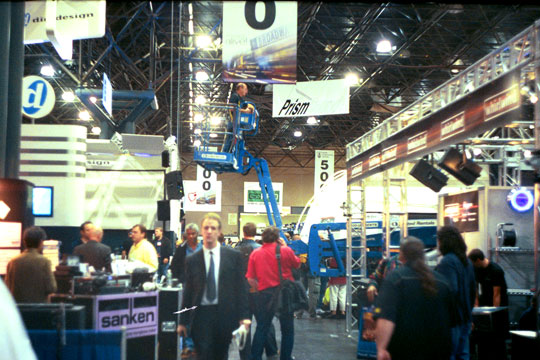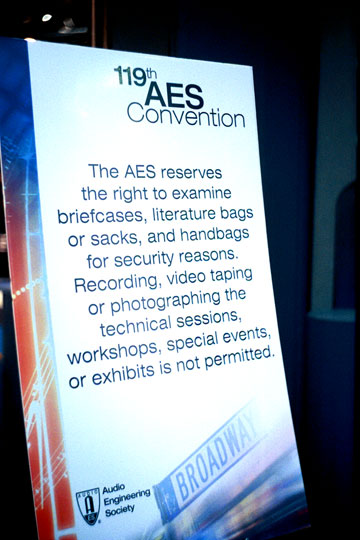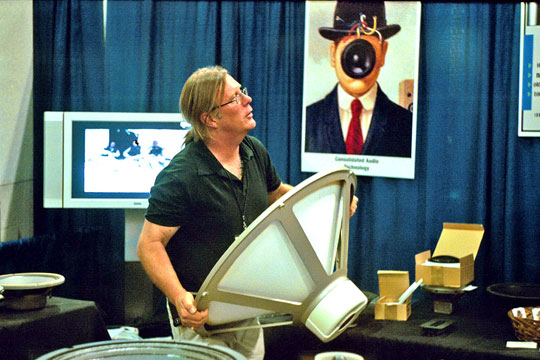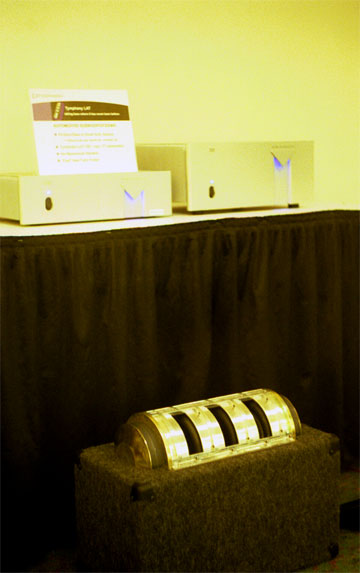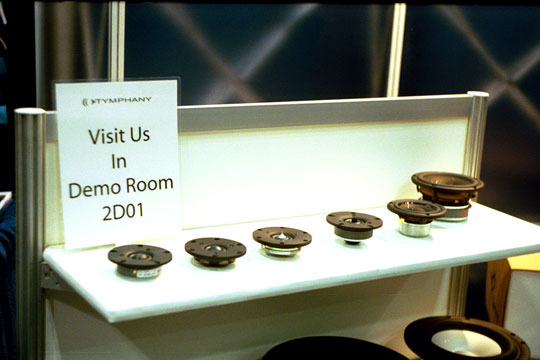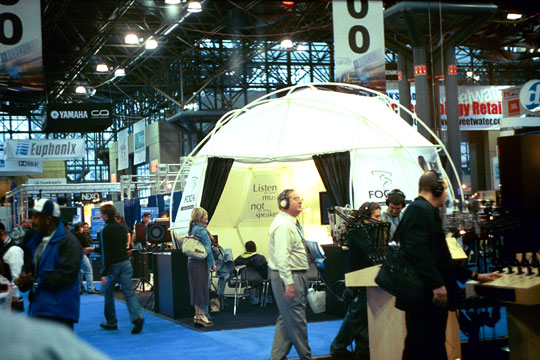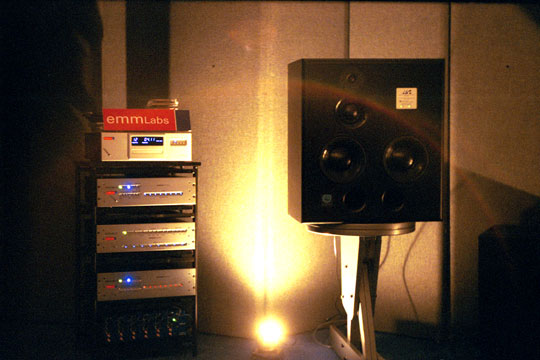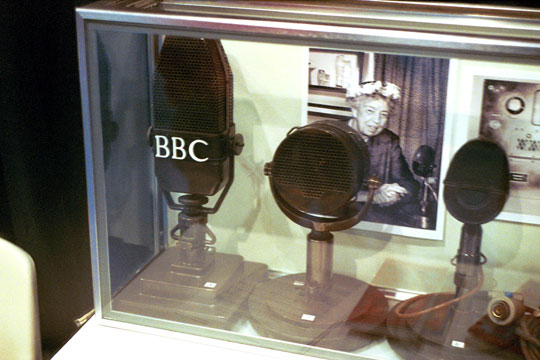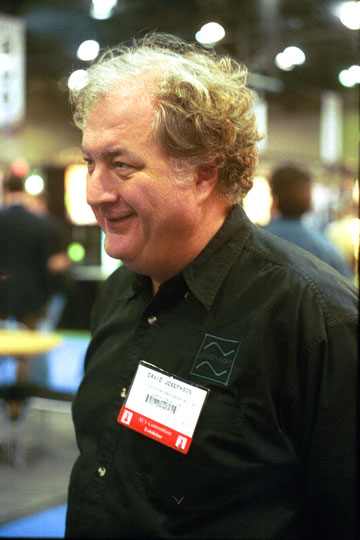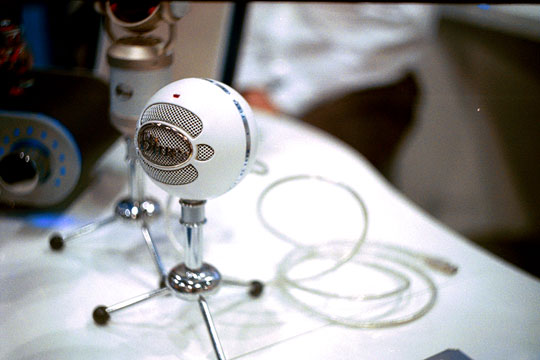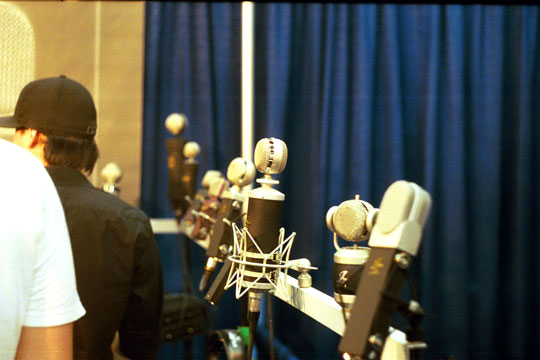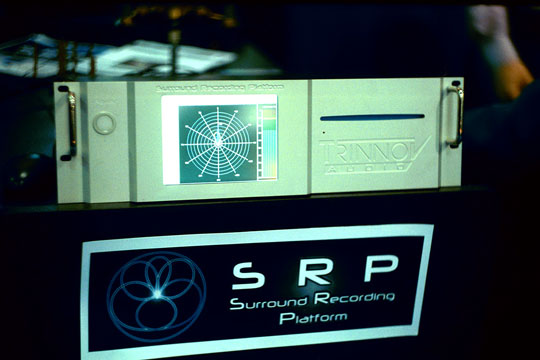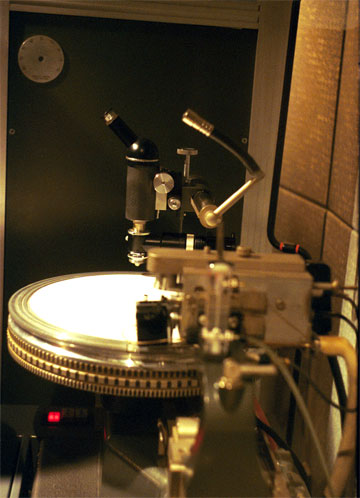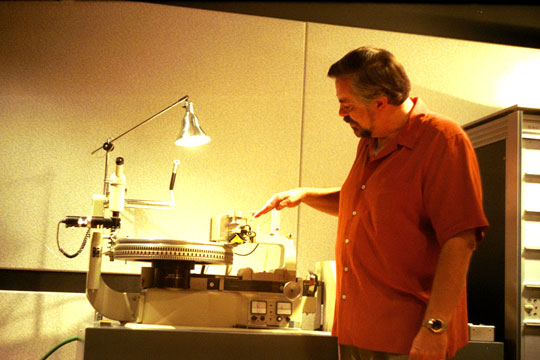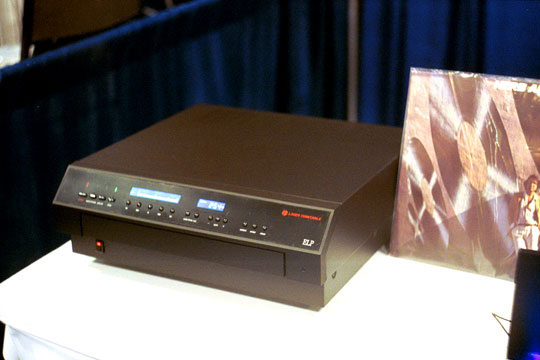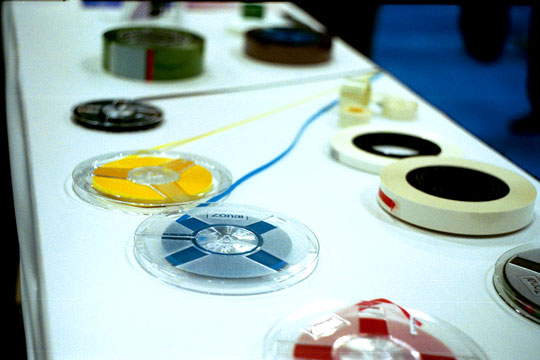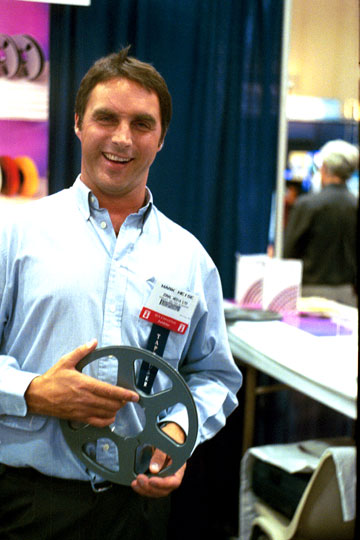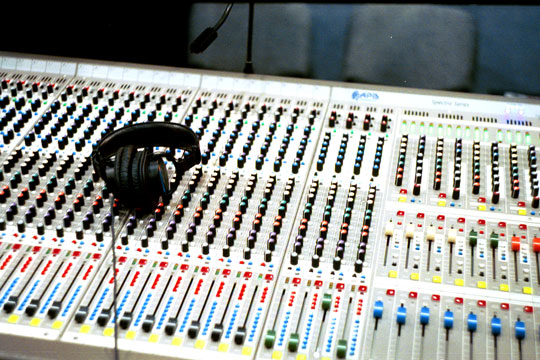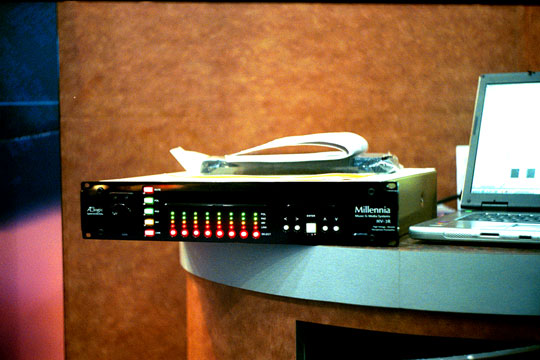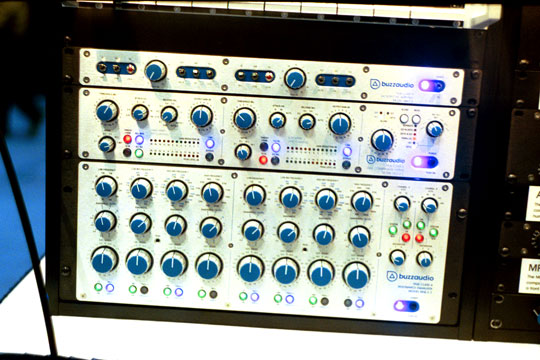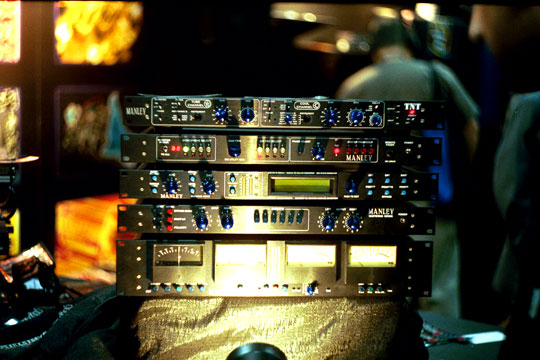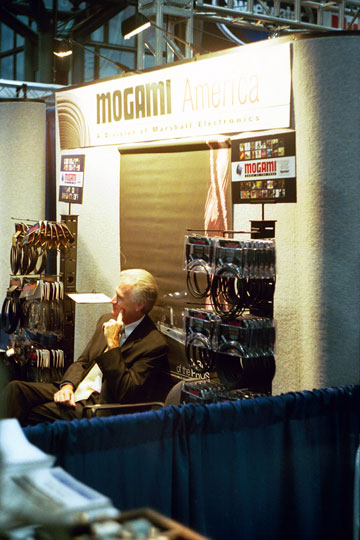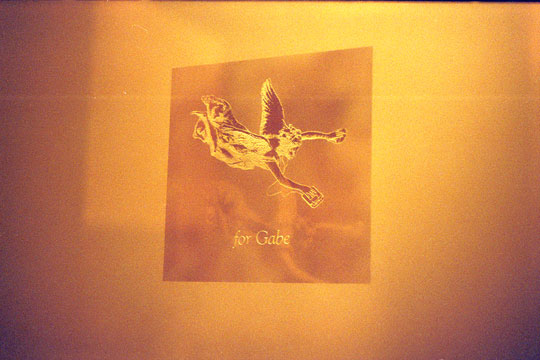|
You are reading the older HTML site
Positive Feedback
ISSUE
22
Dorsey on Audio:
The AES 2005 Show
[All photographs by Dorsey and unindicted co-conspirators; image processing and effects by Robinson] AES 2005 RECAP First, a few thoughts about the show. One of the big things this year were portable field recorders that used internal hard disks or flash media. They went from handheld gadgets with 1/8" phone inputs to 8-channel ones the size of an octavo book that had real mike preamps. I didn't review any of these in this article, but it was a big deal at the show. There was not a single DAT machine on the show floor, and I think this really does herald the final end of DAT. On the other hand, Tascam had two models of cassette deck on display this year, and I find it very sad to see the compact cassette outlasting DAT.
Last year's show had a huge amount of SACD stuff. Not only was there a huge SACD presentation from Sony, a joint SACD manufacturers' booth, But everybody was showing some sort of DSD device and pretty much all of the loudspeaker demos were being done with DSD sources. This year the only DSD stuff of any sort to be seen was the Sonoma workstation being used in the demo of the ATC monitor speakers. It's been a very sudden pull-out. This year at the show there are four analogue tape manufacturers. Quantegy, the former Ampex Media Division was showing tape. The guys from Zonal in the UK are putting the company back together after they were dissolved nearly a decade ago, and they actually are shipping tape based on the old Zonal formulations which they are having made for them by a third-party coating plant. RMGI was shipping tape based on the old BASF/Agfa/Emtec formulations. And ATR Magnetics was very close to actually being in production with their new tape formulations.
Now, one thing that has long irritated me is that the AES show has actually become two events. There are technical sessions in which tutorials and papers are given, and there is an exhibit hall in which vendors show products, and there is really no connection between them. This year there has been some attempt to mix them, with some vendor-run tutorials as part of the technical programs. But most of the folks who go to the exhibits don't even know that the paper session exist, and many of the folks attending papers don't bother looking up in the exhibit halls. As far as I know, this is the only media outlet that talks seriously about both, which I think is a shame. SPEAKERS
Todd Whitford from Consolidated Audio Technology
Jennifer Stagnaro from Tymphany was demonstrating a prototype of their new bass driver, which uses discs driven by a pair of linear servos to move a lot of air volume in a small amount of space. You can imagine it as an oversized version of the old Heil ESS principle. The demo used a Vector Research CD player and a pair of Aragon amps (with a somewhat doubtful Rane digital crossover hidden under the table), going into a pair of NHT Super Zeros. In spite of the very high crossover point required for the Super Zeros, the bass image was stable and you could very cleanly hear the attack on the strings and the full note of the string bass on the test recording I brought along. Tymphany is now owned by Scan-Speak, and they had a variety of Scan-Speak drivers on display at the booth but didn't actually have any for audition. (They were, though, introducing a new soft dome tweeter at the show, the D3004/6600).
More of the Tymphany speaker line Consolidated Audio Technology in Pompton lakes, NJ, had a booth and was talking about their speaker re-cone services. They seem to have a good bit of skill at working on some of the older drivers out there. I talked with Todd Whittford at their booth, who seemed to really understand the difficulties of working on the Altec 515, for instance. Griffin Audio was showing off their smaller ribbon loudspeakers, the G2A. These are mid-sized active speakers (meaning they have their own amplifiers inside the box). From what I have heard of the larger Griffin speakers, they should well be worth listening to, but there was no actual demo space at the show for them. Craig Bell from Bryston was showing the Bryston power amps, and also a line of powered monitor speakers from Energy which are being sold through Bryston. I found the demo of the Energy E9A to have really bizarre imaging; on first listen I thought the two speakers were out of polarity. There was also an odd mid-bass hump. But this is really the sort of thing you expect for a demo on the show floor, because it's almost impossible to set up a demo properly given the haphazard acoustical environment at the show.
The Focal guys attempted to control the acoustics by getting a large booth area and putting a sort of geodesic dome structure up with interior sound control panels. Unfortunately they wound up with a room that was very damped at high frequencies but had some weird problems in the low end. Even so, it was a better than average demonstration for their SM11 powered monitors, which have a very smooth and clean top end without any dome-tweeter spittiness. The low end seemed to move around, and the Peter Gabriel concert recording they were using as source material was incredibly spitty, so I don't think the demo did justice to what is in fact a really wonderful set of speakers. Dynaudio was also showing some very good active monitors and let me do a short demo with my own material. I found the BM-6 to be very recessed sounding in a way that I (as a Magnepan user) like a lot, but with a slightly strained sort of midrange. Crisp top end without being harsh. The larger speaker, the BM-15, seemed to have a cleaner midrange as well as a little more bass extension. What mostly struck me about these speakers was the huge sweet spot, though. You could get a reasonably good image almost anywhere in the room. Also, for the first time at the US show, Musikelectronic Gethain was showing their coaxial monitor speakers. This is a company from the former East Germany that makes monitors with some of the cleanest midrange that I have ever heard. I can't say enough good things about these people and the RL-series speakers. They have been at many European shows, but I am very happy to see them trying to get some distribution here in the US . JBL had a number of speaker products in their demo room, but the one that I found most interesting was a coaxial ceiling speaker designed with a real compression driver, for controlled dispersion in very large rooms with high ceilings (like airport terminals). Unfortunately nobody there could tell me anything much about it.
ATC SCM1.0 monitors with the EMM Labs DSD system ATC was showing their new SCM1.0 large studio monitors, using a Sonoma DSD workstation as the test source. I asked them to play some of my own CDs through the system for some source material that I knew. These things didn't have the cleanest midrange, and they were a little sibilant, but they were just incredibly forward sounding. Anywhere you were, they were very much in your face. This can be a very desirable thing for a soffit mounted monitor that is more for the customer than the mix engineer, and I think these speakers fill that bill nicely. Downstairs at the paper sessions, Shiva Sundaram and Chris Kyriakis from USC gave a talk on Phantom Audio Sources with Vertically Separated Speakers. For a lot of home theatre applications, it's impossible to locate the center channel speaker directly behind the screen (as is done in normal theater systems). These folks used a speaker above the screen and one below it and used some filtering to make the signal appear to image in the center of the screen. Very nice application of inverse filtering to actually provide benefit in a real-world system. Preprint 6614. Neil Harris and Graham Bank from NXT Transducers gave a talk entitled A Balanced Modal Radiator. NXT has been engaged in construction of distributed mode loudspeakers, that is, flat panels that are intended to operate in break-up modes. The radiation pattern from these systems is naturally very different than a typical loudspeaker. This paper details the design of a flat diaphragm speaker that acts much like a real point source, with a flat on-axis pressure response and linear power response. They start with a conventional loudspeaker motor driving a flat panel, but then add balancing masses to manage the break-up modes in a controllable way. Preprint 6595. Another very unusual driver configuration was shown by Juro Ohga, Hirozaku Negishi, and Ikuo Oohira, in A Proposal for Low Frequency Loudspeaker Design Utilizing Ultrasonic Motor. They detail a piezoelectric motor that uses a series of flexing elements to producing a rotating motion. These motors are standard devices which are commonly used in applications like focusing motors for auto-focus cameras, but these people are using them to rotate a multi-blade fan to move air in a controlled fashion, or to move a diaphragm in a similarly controlled way. Unfortunately, they find the motor has substantial inertia, but they find two ways around this, using a system that allows the motor to be continuously rotating but have its speed modulated by signal. Preprint 6581. David Henwood and Gary Geaves gave a paper on Finite Element Modelling of a Loudspeaker Part 1: Theory and Validation, in which they discuss the construction of a mathematical finite element model to emulate a speaker driver, how they verified the driver against actual drivers, and how the model worked. This was in preprint 6582. Then, in an additional paper called Finite Element Modelling of a Loudspeaker Part 2: Applications, they were joined by John Vanderkooy who used that model to show how changing mechanical elements of a driver affects the sonic behaviour, things like changing the cone shape and stiffness and the distribution of the damping. Highly recommended. Preprint 6593. Wolfgang Klippel gave a talk entitled Speaker Nonlinearities — Causes, Parameters, Symptoms. This wasn't an announcement about some innovation, but it was a great overview on the basic sources of nonlinearity in speaker drivers, how to measure them, and how to locate the particular design problem from the measurement. A very good introduction to anybody interested in driver design. Preprint 6584. Another paper on driver linearity, but from a totally different perspective, was Delphine Bard, Mario Rossi, and Mauro Del Nobile talking about Compensation of Nonlinearities of Horn Loudspeakers. These folks didn't look into what caused amplitude linearities, but looked on the horn speaker as a black box. They used digital signal processing techniques, applying a Volterra series to model the nonlinearity from measurements, constructing an inverse Volterra kernel to compensate for it, and then measured the combined horn system to find much lower distortion and better tracking of the original signal. The testing was only approximate, with a gross THD value being formed, but given the high distortion of typical horn systems this is pretty useful. It would have been interesting to see actual listening tests, but the whole notion of using the Volterra kernal to compensate for device nonlinearities is a very new one and one that is worth looking at. Preprint 6573. A paper that was sort of about speakers, but which could be generalized to a lot of different things, was A Spectrogram Display for Loudspeaker Transient Response by David W. Gunness and William R. Hoy of EAW. These folks point out some of the limitations of the ordinary windowed FFT in generating waterfall plots for speaker measurement. They then show a rather nifty way of calculating waterfall plots from a time-domain signal, using wavelets. This reduces some of the artifacts that often pop up in conventional waterfall plots. Check out preprint 6568. Another paper that was kind of about speakers but mostly about rooms was Adrian Celestinos and Sofus Birkedal Nielsen's Optimizing Placement of Multiple Low Frequency Loudspeakers in Rooms. These folks did some room simulation in Matlab with a number of small rooms tested, and they found various configurations of multiple subwoofers with phase shift networks that would help deal with room modes. This definitely does not look like a cure-all, but it's an interesting step toward helping to deal with room problems at low frequencies. Preprint 6545. MICROPHONES
Courtesy of the New York City local AES section and part of Malcolm Addey's personal collection. The big news at the show is that, after thirty years of saying they never would make a shotgun mike, Schoeps was showing a shotgun mike. The CMIT5U appears to be a hypercardioid capsule with a short interference tube added, so it's a lot smoother off-axis without the lobing of a conventional hypercardioid. I was very impressed with the demo of the unit on the show floor which seemed as good as the old Sennheiser 416 at pulling sounds out of the muck, without the unfortunate sonic side-effects of the 416.
David Josephson of Josephson Engineering Josephson Engineering was demonstrating their model C617. This is a condenser microphone with a modified version of their standard Series Six electronics that can provide 200V polarization. This is provided with a 1/2" IEC Type I measurement capsule, giving you a calibrated omnidirectional measurement mike that can be powered by standard 48V phantom. This is both a fine thing for people who need repeatable calibrated measurements, and people who want the most neutral-sounding possible omni for recording acoustic music.
David Josephson and Scott Dorsey The fellow from ACO Pacific was also there, showing off a wide variety of measurement microphones and measurement products, including some very fine outdoor microphone systems for noise studies, and accessories like calibrators. Violet Design from Estonia had some very interesting-looking microphones. These guys were originally a subcontractor making parts for BLUE microphones and decided to set out on their own. They have some very impressive industrial design and some mikes that look great. Sadly they don't seem to have spent as much effort on the sound as on the appearance. Stanislav Rubintsik did his best to give a good demo but did not seem very knowledgeable about the products he was selling. These guys also listed a “frequency range" on the data sheet with no tolerances, and a rather heavily-smoothed chart on the same data sheet which indicated those tolerances must have been about 6dB.
The BLUE Snowball BLUE themselves had a wide variety of new products, including an inexpensive USB-output microphone called the Snowball, and they were celebrating both their tenth anniversary and their new distribution through the Telex/EVI empire. I've always liked BLUE, because their designs basically start out with Skipper Wise's personal thoughts about what a particular sound should be like, and end up with Martin Saulspurens' implementation of that idea. Their microphones are mostly very colored, but they are colored in very particular ways to do very particular things, and even if they don't have the sound you want you have to respect their vision. Bob Heil from Heil Sound was showing off a line of dynamic microphones, including a small stage microphones, the PR20, and studio microphones with larger diaphragms, the PR30 and PR40. All have very good rejection and extreme presence peaks for very strong voice articulation.
A THE microphone Taylor Johnson , formerly from the Sound Room, has moved down to Argentina where he is heading up Taylor Hohendal Engineering, which makes the THE microphones. He had an impressive array of very well-made but reasonably inexpensive microphones for sale, and a lot of very fine stories about the land of the pampas. (I did rag on him about his marketing information listening frequency ranges without tolerances, though.) Wes Dooley from AEA was showing off a variety of neat accessories like stands and positioning devices, as well as his replicas of old RCA ribbon microphones and his ribbon microphone repair services.
Violet Microphones A new company is also making some ribbons. Crowley and Tripp is a small organization that makes acoustical transducers for medical applications, which has branched out into making studio microphones. They have a complete line of four ribbon mikes, all with rising top octave responses and much higher ribbon tension than typical designs. How do they sound? I don't know, but I'm certainly interested in finding out. Telefunken USA was at the show, not only showing their modern reproductions of the old ELA M 251 mikes, but also a U47 copy, a C12 copy, and a new line of “RFT" microphones with metalwork from China and electronics made in the US along with NOS tubes. Oh yes, and they had a VW bus on the show floor, which is a hard exhibit to beat. Down in the technical sessions, a poster session was given by Jun Lee of Shenzhen Horn Electroacoustic Technology Co. Ltd, called Investigation on the Related Effect Caused by ECM Miniaturization. He talked about some of the fairly well-known effects of changing dimensions in electret condenser microphone capsules. Nothing he presented was in any way innovative and most of it was in Olson's 1964 book on acoustic engineering. Even so, this could have been a good overview on condenser microphone physics if the presenter's command of the English language was a little bit better. As it was, it was difficult to figure out what was going on. Eddy Brixen from DPA in Denmark gave a talk called Microphones, High Wind and Rain. It was a nice overview of noise problems caused by high wind and rain, effects familiar to anyone who has worked an outdoor music festival. He showed a number of methods for evaluating sensitivity to wind noise, and effectiveness of windjammers, and then proposed some standard measurements. Preprint 6624. Fang-Ching Lee from the Industrial Technology Research Institute in Taiwan talked on an Electroacoustic Analogy Analysis of Electret Condenser Microphones With Noise-Cancelling Effects. This was an interesting model of a noise cancelling microphone capsule, done as an electrical analogy to the mechanical system. It looked a lot like some of Marshall Leach's work in the eighties, with some changes due to the noise cancellation effects. Preprint 6616. SURROUND
Trinnov Audio from France was showing off a microphone array using seven omnidirectional microphones, the outputs of which go into a DSP device that uses beam-forming techniques to produce a standard 5.1 output. The system was set up so that you could use your choice of microphones and preamplifiers with the outputs running into their matrix box. Among other things, this allows the patterns of the “virtual microphones" to be adjusted on the fly to get proper imaging in any room. The theory behind the system seems sound, but they didn't have any demonstration of the unit at the show. Joerg Wuttke from Schoeps gave a paper called Surround Recording of Music: Problems and Solutions, which was a good overview of the difficulties of making natural minimalist-miked classical recordings for multichannel surround systems. Most importantly, he first talks about what we can really expect from typical 5.1 systems and what we shouldn't expect, with some notes about minimum requirements for a playback system. He then goes into detail about some of the popular microphone arrangements for surround pickup with some notes about how we actually perceive imaging. This is probably the best introduction to surround imaging and recording for surround that I have seen, and came in as a close second for best paper this year. Preprint 6556. Another, slightly less detailed, paper about minimalist surround recording methods is Colin Preston's Alternative Approaches for Recording Surround Sound. He shows a number of microphone configurations, some of which are detailed in Wuttke's paper, but not all of which are. Preprint 6623. One of the older methods for surround recording is the ambisonic array, which normally uses four cardioid microphones arranged in a tetrahedral array, from which four signals are generated using summing and differencing. A variety of different outputs can be derived from this “B-format" set of signals, varying from standard quadraphonic, 5.1, and a fold-down to stereo (which approximates the output of a coincident cardioid pair). This makes the ambisonic array a very versatile way of recording sound because it can be released in different formats. However, the cardioid capsules used are not the most neutral designs. In The Native B-Format Microphone: Part I, Eric Benjamin and Thomas Chen from Dolby Labs talk about an array of omni and figure-8 microphones which can directly produce a B-format signal without any matrix operations, and which uses capsules which are naturally more neutral off-axis. Very worthwhile if you are at all interested in ambisonic recording methods. Preprint 6621. One method of reproducing a realistic image of a room is with sonic holography, or another system that employs a circle of speakers surrounding the listener, which uses some interference transform to attempt to reproduce the actual shape of the wave field that was picked up by a microphone array. In Simulation and Visualization of Room Compensation for Wave Field Synthesis with the Functional Transformation Method, Stefan Petrausch and friends demonstrate a new simulation method for calculating the wave field of a simulated room, so they can simulate any acoustical space fairly accurately with a similar speaker array. Preprint 6547. A similar sort of reproduction system was shown in An Immersive Audio Environment with Source Positioning Based on Virtual Microphone Control, by Jonas Braasch, et al. However, it was used only to playback recordings made by spotmiking and assembled with the individual tracks panpotted around the room. The center of the paper was basically on their algorithm for panpotting the individual sources. Preprint 6546. Not really surround, but Pablo Faundez Hoffman and Henrik Miller from Aalborg University talked about synthesizing artificial binaural recordings, with the position of each instrument in the soundfield processed through a head-related transfer function and all of them summed together to give a realistic binaural image. They point out that doing this, you have to switch between different transfer functions as a sound source is panned around the soundfield, and so they investigate the audibility of these panning effects in Audibility of Spectral Switching in Head-Related Transfer Functions, preprint 6537. LP STUFF
Carl Rowatti demonstrates the 45-45 stereo configuration Really no vinyl cutting out on the show floor this year, with Apollo and Transco not even showing off their lacquer blanks. However, we did do a great tour of the Trutone mastering studios, where Joe Lambert talked about mastering CDs and Carl Rowatti talked about mastering for vinyl. We got to hear some unmastered and then mastered material on the KEF 207 monitors in the B studio, driven by McIntosh 2100 and playing some Alice Ripley recordings. Then over in the A studio, Carl cut a 16 KHz tone on the outer edge and the inner edge of an LP and showed more than 6 dB difference in level between the two, due to the difficulty of tracking on the inner grooves. Really a great demonstration. He also showed how difficult sibilant material was to cut.
Keith Taruski from Laser Turntable, Ltd. was showing off the latest iteration of the laser turntable design. The unit he had looked a lot like the old Finial in concept, but with a much simpler setup. He also was demonstrating some software called DC Six, which is a package that contains a variety of audio restoration tools, many oriented toward disk archive work. TAPE
Tape display from Zonal Media Tape was very exciting this year. The guys at Quantegy had a booth for the first time in four years or so, and were showing off their line of standard mastering tapes. I got to talk to Michael Porter there about some of my experiences with the current production, and he was just happy to talk about the company and let people know they were still in business and still shipping tape. Don Morris from RMGI was showing their version of the BASF 900 and 911 formulations. He said that their factory in Holland should be producing a BASF 468 equivalent tape within a few weeks as well, which is a great thing.
Mark Heise of Zonal Media Mark Heise from Zonal Media was there also. After a decade, Zonal is back in business, with a third-party coating plant making tape to their original specifications. They are trying to bring back most of the old Zonal catalogue, with pretty much everything but the high output Zonal 999 slated for production. Right now they are shipping tape (and the have a large glut of 1" type 675 tape, incidentally, for anybody using 1" machines right now). Almost as interesting, Zonal has a line of leader and splicing tape, as well as reels and a lot of the other materials that are needed for analogue production. They had a very slick little automated splicing machine as well, which looked faster than a hand splicing block to operate. Mike Spitz from ATR Magnetics was in their booth. After many years of rebuilding Ampex ATR-100 machines and manufacturing retrofit parts for those machines, Mr. Spitz is branching out into the tape manufacturing business because he sees it as something he needs to do in order to serve his tape-using customers in a world where tape is becoming increasingly difficult to get. They aren't actually shipping tape yet, but they had some photos of their new production facility and were very enthusiastic about having some beta test samples very soon. I talked to Eileen Karczmer of Servoreeler and Xedit, and she gave me the sad news that Xedit is soon to be out of the splice block business. They are talking about selling all of the machinery, since they are now primarily making remotely-controlled microphone reel devices that can conceal microphones in the ceiling or drop them into position. Since the tape splicing products business is not a growing one, it makes good financial sense for them to get out. If you need splice blocks, better hurry and get them now! PARTS There were a lot of IC vendors there, including TI/Burr Brown, Analog Devices, and Wolfson Microelectronics. The only folks I spent any serious time with, however, was THAT. Marvin Hahn from THAT said they had finally released their long-awaited 1512 chip, a pin-compatible replacement for the SSM2017 microphone preamplifier. This is going to be a huge upgrade for a lot of people using consoles and preamps based on the (rather poor) SSM2107. As the SSM2107 has been used in a few phono preamplifiers as well, it may interest some of the home hi-fi guys as well. Penta Labs was showing off a line of high-grade Teflon capacitors, as well as some oil-impregnated Teflon types. Very low leakage, for things like condenser mike input stages, but they also had huge values going up to a full 1 uF at 600V, so these could be a great choice for coupling caps in tube gear. Sunrise from China once again was showing off a nice line of inexpensive large toroid power transformers. Plitron had a somewhat more extensive line of high grade toroids, and of course Lundahl was showing off their line of top-quality audio transformers. Lundahl has lots of small-signal transformers but also some excellent tube amp output transformers in the European wrapped-core style. There was even a paper about parts! Jim Brown from the Audio Systems group talked on New Understanding of the use of Ferrites in the Prevention and Suppression of RF Interference to Audio Systems. It's long been known that ferrite beads and cores are more effective at RFI suppression than they should be if modeled as a simple choke. This paper talks about some of the parasitic effects that wind up making them more effective, but then goes in with a practical discussion about how to use them most effectively, and how to size them properly for a given application. Most useful in its combination of theoretical and practical discussion. Preprint 6564. CONVERTERS A number of vendors were showing products in the exhibit hall, but I didn't have much time to check them out in great detail. What I found sad was the complete lack of DSD converters on the show floor. Another depressing thing is that I talked with the Monster Cable people about their Entech line, which has been discontinued in the last year or two. They made a very good D/A converter, and nobody at the booth had any idea what happened to the line. There were some interesting papers, though. Richard Kulavik and Larry Gaddy from AKM Semiconductor wrote on Understanding the Effects of AES-17 When Evaluating 192 KHz Converter Performance. The AES-17 specification is a standard for measurement of digital audio equipment, including converters, but it has a few pitfalls in it. Some manufacturers have been building high speed converters with considerable out-of-band noise, so that they measure well under AES-17 but may not actually perform well in the real world. Some of the details of the specsmanship and how to verify measurements are included in preprint 6578. Paul Lesso and Anthony Magrath from Wolfson Microelectronics were talking about An Ultra High Performance DAC With Controlled Time Domain Response. It's kind of hidden in the title, but this was basically a paper about oversampling filters, and the basic need to balance the need for low group delay (i.e., flat phase response), low filter ringing, and computational complexity. It's a very interesting look into the design of oversampled converters and into digital filters in general. Preprint 6577. PROCESSORS The guys from Bricasti Design, a company I'd never heard of before, were showing a new reverb unit based on traditional digital reverb algorithms. The Model 7 was a small 1U box with 2-channel analogue and AES/EBU inputs and outputs, and looked like a flexible little box. Now that so many of the higher grade reverb units have been discontinued in favor of plug-in equivalents, this is a very big deal and very much needed. What wasn't so was the demo of the TC Electronic Voice Pro. This is a DSP box with a lot of algorithms that can be used to alter vocal sounds, and I found it really quite annoying. Everything that they ran through it sounded very artificially processed. It may be a powerful tool for vocal editing, but you couldn't tell from the demo which seemed to make it out mostly to be a powerful tool to make vocals sound fake. What I found most sad is that everybody else in the demo seemed really enthusiastic about the processing, while it seemed everything that I heard went out of the way to make the vocal sound less realistic. MIXERS Malcolm Toft was showing off a small console he'd designed for Studio Projects. This is an inexpensive, Chinese-made console that is built like the real thing, with individual boards for each channel, long faders, socketed ICs, and a reasonable control layout. Priced like the cheap music store consoles, but with a lot more flexibility and repairability, it looks like it could be a winner. Audio Developments from the UK was showing a very neat little six-channel field mixer for film sound work, which might also be a great choice for live-to-2-track work in the field. Very solidly built and very well-designed, it's certainly in the same league as the Sonosax gear which is something of a standard reference in that market. All of this equipment is basically hand-built at this level. Trident had their usual line of consoles, but what really stood out for me was the S140 matrix mixer, with eight channels in and eight channels out and the ability to make eight different mixes from the eight sources. Very much a handy thing for making headphone mixes in the studio, and in fact it has a set of headphone amps in it for just that purpose. Really this is the first all-in-one unit like this that I have seen since Roland discontinued their matrix mixer in the seventies. Speck Electronics was showing the LiLo, for Line-In, Line-Out. This is a 16-channel fully modular console with the nice solid layout of a traditional mixing console, but with no preamps and no EQ. It's intended for people recording on a digital workstation who want to mix down to 2-track “out of the box" rather than engaging in the frustrating enterprise of trying to mix with a mouse. But, it could also be a great console for people doing any sort of minimalist recording work where the clean signal path and lack of unnecessary features is an advantage. Speck also had a 16-channel 1U rackmount mixer that would have been just perfect for monitoring in my remote recording rack if they had introduced it two years earlier.... but it might well be perfect in someone else's next remote rack.
A console from APB Dynasonics A new company this year, APB Dynasonics, was selling some interesting new large-format recording consoles, with digitally-controlled analogue electronics. I wish I'd had a chance to check their gear out more carefully because in the current environment, anybody making a good large console is very welcome. PREAMPS John Hardy was showing off not only his usual line of fine transformer-input solid-state preamps, but also a couple of different modules intended to replace the input stages on standard consoles. He had also a drop-in replacement card for the API 325 amplifier module that was used both in their consoles and in a lot of distribution amps and racks. I didn't see anything new at Great River Electronics, but their preamps are so good that I think they deserve as much attention as they can possibly get. They also have an equalizer that looks like it's worth checking out as well.
The Millenia HV-JR John La Grou from Millenia Media was showing a remotely-controlled version of their HV-3 preamplifier. It's a rack of eight preamps that you can put up on stage, then control the gains on the preamps from a remote box up in the booth. This allows recordists to run line level signals from the stage up the long run to the booth or remote truck, rather than having to locate the preamps far away and running long mike-level signals.
A Buzz Audio stack Buzz Audio , a company from New Zealand, was showing their MA2.2 class A microphone preamp. Extremely well-made unit, and one that I had heard a lot about. With the current urge for coloration, there are fewer and fewer really clean-sounding preamps out there and it's good to see another one. EQ
A short stack from Manley Labs Manley Labs was showing the Mini Passive. This is so new that it's not on their web site, they didn't have a cut sheet on it, and I can't find all my notes. By memory, it's a two-band two-channel equalizer in a 1U space, with the same basic passive design as the Manley Massive Passive, just with fewer bands. And yes, the Q is adjustable, which is a big deal for me, anyway. Buzz Audio also was showing the Resonance Equalizer, another RLC-based filter bank unit with adjustable Q and real inductors in the signal path. Prism was showing off their line of processing, which included a very impressive mastering equalizer designed by Leif Mases, who used to work with Abba. He was a very interesting person to talk with, and having used his equalizer I can say it's very fine. Duane Wise talked on The Design of Half-Band FIR filters Using Ripple Attenuation of a Manipulated Lowpass. FIR filters are very handy digital constructs because they exhibit very nice amplitude characteristics with no phase shift. However, they are much more difficult to calculate and require more compute power than an IIR filter that emulates analogue filters. However, there is a nifty trick called a “half-band" filter that provides a decent approximation of an FIR filter with less computation. Mr. Wise shows a nice trick to get better performance out of this half-band approximation. Preprint 6602. ACOUSTICAL PRODUCTS One new acoustical company that I'd never seen before at the show was Saatifil Acoustex. These guys make precision fabrics with controlled acoustic characteristics, for things like microphone and speaker grilles. Much higher precision than typical grille materials, and far higher than that of the fabrics normally used for bass traps and the like, they basically make very small parts and rolls where critical weaving is necessary. Of course, the usual folks like Auralex and Audio Tile were there as well, as well as RPG Diffusor Systems. Most of this stuff isn't innovative or unusual, but it's still absolutely essential to deal with room problems. If the room acoustics aren't good, nothing is good. Modeling of speakers in actual rooms is normally done with ray-tracing systems have a three-dimensional map of the frequency response of the speaker in all directions. This works with some degree of accuracy, but Stefan Feistel and Wolfgan Ahnert, in The Significance of Phse Data for the Acoustic Prediction of Combinations of Sound Sources go and add an additional array containing the phase response in each direction. They find, not surprisingly, that this gives much better modeling of multi-speaker array configurations. But they also find that it gives much better modeling overall, to the point where accuracy is an order of magnitude closer to that of a physical measurement. Preprint 6632. CABLES
At the Mogami America booth Lots of bulk cable manufacturers, like Belden and Mogami. A couple of companies that did custom cables as well, like Gepco. And this year for the first time, Monster Cable got themselves a booth. But not much cable representation at the show. OTHER STUFF There were a few actual dealers with booths. The guys at Tekserve Pro Audio had a really neat booth with a lot of vintage gear on display, and a lot of new gear for sale. Dale Pro Audio had a booth, and so did ProShow from down here in Virginia (who were showing off the RAM amplifiers and a wide variety of speaker drivers). John Walker from Zenph was showing off their system, which basically transcribes a piano recording into individual note data which can be played by a Yamaha player piano system. The accuracy was quite good, with old Glenn Gould and Art Tatum recordings sounding very much like the original recording (save for Gould's humming). Audio magazines these days seem to be getting slimmer and slimmer with page counts all down since 9/11. Still, there ere a lot of folks from smaller magazines I'd never seen, like TV Technology and Multi Media Manufacturer, as well as the usuals like Recording, Mix, EQ, Voice Coil and AudioXpress. The folks from Broadcast Engineering were showing a magazine simply called Radio, and the folks from Resolution were over from the UK. I should mention Recording magazine here as well, since I occasionally write for them, and they had a booth also. Under Cover was showing off their surprisingly inexpensive and well-made custom covers for any sort of audio equipment. Very handy for anything that you don't use everyday, from turntables to entire large format consoles. Their presentation was marred only briefly by a man with an 8-foot long guitar fumbling on the strings at deafening levels. I mentioned in the preamble that a lot of folks were showing portable field recorders but I didn't check them out. Actually, I did check out one of them, the hhb Portadrive PDR 2000. Eight channels in and out, some mixing features so you can hear what you're recording on a single pair of headphones, and a little 2.5" hard disk drive that you can either remove and drop into a PC or Mac, or copy data from over USB or Ethernet. Very slick. hhb was mostly selling their FlashMic, though, a small solid state recorder built into the handle of a microphone for reporters. Rohde and Schwarz was showing their line of test equipment, which not only included audio gear like their FFT analyzers, but also some RF gear like their FSH-3TV, a combined spectrum analyzer for the TV bands and an analog and digital TV set in the same handheld box.
The Chandler Limited preamp/compressor Oliver Archut from Tab Funkenwerke did a really wonderful tutorial on the evolution of German audio production gear in the fifties and sixties. He preserved a lot of records that Seimens and TAB discarded over the years and in many ways is one of the great experts on this equipment, so it was very interesting to see his slides on how this gear was made and hear his discussion of what went into it. Chandler Limited, which has in the past made clones of older EMI studio gear, is now making a preamp and compressor of their own design using newly manufactured germanium transistors. They won't tell me who they have got making germanium stuff for them, but the assure me it's not NOS at all. The preamp is conventional with input transformers, while the compressor uses germanium diodes as the compression element, not just as a detector. Why germanium? We won't know until we hear how it sounds, and that wasn't possible at the show but should be possible soon. Elichi Miyasaka and Takahiro Kamada gave a talk entitled Difference of the Sound Levels Among 15 Japanese Terrestrial and Digital Satellite TV Broadcasting Channels. These folks found that the average sound level of the terrestrial channels was 4 dB higher than the digital channels of the same program on the average, the difference between commercials and programs was as much as 15 dB, but the average level difference between channels was fairly small. They imply that the wide dynamic range is a problem for elderly listeners, while I am more apt to think the wide dynamic range is a good thing. Either way, the measurements are very worthwhile and quite different than what we see in US broadcasting. Preprint 6615. A really fascinating paper from Jean-Marc Fontaine and Jacques Poitevineau from the Laboratoire d'Acoustique Musical was called Are there Criteria to Evaluate Optical Disc Quality that are Relevant for End-Users? One of the great advantages of the CD is that high disc error rates can be corrected or concealed, but for archive discs this prevents you from knowing that a disc is beginning to fail until the error rate has increased to the point where the error concealment breaks down. These folks discuss various measures that can be made on CD-R discs in order to tell what the actual state of the discs in an archive are, and to predict problems in advance, while discs can still be copied. Preprint 6535. Rob Maher from Montana State wrote a paper that is sort of hard to characterize here. Acoustical Monitoring Research for National Parks and Wilderness Areas details some of the work that has been done within the National Park System to characterize and evaluate man-made noise. Part of the environment that is preserved in the parks, the environment that people come to see there, is the sonic environment. Sound monitoring lets us know how it is being changed by recreational vehicles, tour aircraft, and industrial activity. Preprint 6609. Another interesting but hard to classify paper was Eric Benjamin and Brett Crockett's talk Preferred Listening Level in the Automobile Environment. I actually walked into this talk by mistake, trying to find another paper, but it was interesting enough that I stayed. These folks characterized automobile noise, and then found out what preferred listening levels for a sample listener group was, under various automobile conditions. They found the C-weighted or unweighted noise was independent of speed, but the A-weighted noise (and thus the perception of noise level) was pretty much linear with speed. How much, and how much did it make people turn the volume up? Preprint 6533 will tell you. END
The entranceway to the Ars Nova theatre. Remembering Gabe Wiener…. It was definitely an interesting show, and it was good to see a lot of old materials and techniques were popular again. The best thing at the show, though, was a party in memoriam to Gabe Wiener, one of the early net.audio people on Usenet. Gabe taught a lot of people about audio and he spread the gospel of minimalist production techniques until he died tragically young nearly a decade ago. Whenever I go to the AES show, I always expect to see him around the corner, and I always wonder what he'd think about the latest in technology. I guess that's helped me out a lot in the way I view the pro audio world, and I hope to spread some of that view to you.
|

